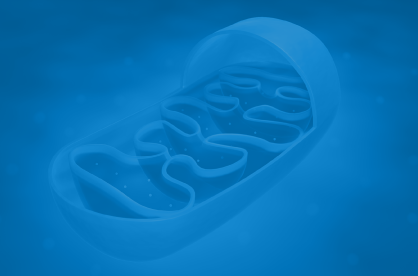
As Dr. Ted likes to say, your mitochondria are the "batteries of your cells” and a result, they play a vitally important role in health, performance, and disease. Ensuring they are well looked after and functioning optimally should be a principal concern for all, even the non-sentient among us!
Each mitochondria within the cell serves as a hub of aerobic respiration or the conversion of fats and carbohydrates into adenosine triphosphate (ATP), which is the energy currency of life. This ATP is then distributed throughout the cell to be used in a diverse range of metabolic processes.
In this article, we will look at eight essential ways to improve or enhance mitochondrial function and, consequently, the production of cellular energy.
Intermittent Fasting
The restriction of calories we consume from food stimulates a process called mitochondrial biogenesis (the building of more mitochondria within the cell). The scarcity of cellular energy causes the cell to kickstart mitochondrial biogenesis to ensure adequate energy production is maintained. This increases levels of nicotinamide adenine dinucleotide (NAD+), a central enzyme in metabolism, which leads to a rise in the production of ATP [1]. If you want to learn more about mitochondrial biogenesis and ways to increase it, read here.
The use of intermittent fasting, or time-controlled fasting, is also known to prevent changes in mitochondria associated with age that can be brought about by consuming a persistently high fat diet (such as that typical in Western countries) [2].
Hypoxic Training
In conditions of low oxygen, such as those seen at high altitudes, or when holding your breath underwater, your cells respond by increasing their number of mitochondria. The release of hypoxia-inducible factor (HIF-1alpha) causes stem cell release and the formation of new blood vessels [3].
Other studies suggest that hypoxia can promote mitochondrial turnover and angiogenesis (production of new blood vessels) in muscle tissue as well as increase the ATP content in muscle, and therefore cellular energy status [4].
Vitamin and Mineral Supplementation
The electron transport chain in the mitochondria requires a steady supply of micronutrients (vitamins and minerals) to make sure that all stages of the citric acid cycle can continue to provide electrons for the efficient production of ATP [5]. Deficiencies in these micronutrients can accelerate the mitochondrial decay of aging [6].
For example, B vitamins and lipoic acid are crucial for the tricarboxylic acid cycle, whereas selenium, α-tocopherol, coenzyme Q10, caffeine, and melatonin are proposed to enhance electron transfer system function. Carnitine is essential for fatty acid beta-oxidation and selenium is involved in mitochondrial biogenesis [7].
Mitochondria are rich in minerals, and they help ensure appropriate physiological function by acting as cofactors. However, these important minerals are often deficient in the Western diet [8].
Hyperbaric Oxygen Therapy
Oxygen is the final electron acceptor on the electron transport chain within each mitochondrion. In the absence of oxygen, mitochondria cannot make ATP.
Hyperbaric oxygen therapy (HBOT) is the administration of 100% oxygen at greater than 1 ATA (atmospheric pressure) [9]. This technique increases the proportion of oxygen dissolved in the blood by five- to twenty-fold.
Using HBOT to provide the mitochondria with more oxygen increases ATP production and repairs damaged mitochondria. In addition to these beneficial effects, it also decreases the production of reactive oxygen species, boosts antioxidant defense mechanisms, and promotes neuroprotection [9].
In healthy middle-aged master athletes, HBOT enhances physical performance including VO2 max (or maximal oxygen uptake) and power, which might be due to improvements in mitochondrial respiration and increased mitochondrial mass within skeletal muscle [10].
A host of diseases are caused by dysfunctional mitochondria and imbalances between reactive oxygen species and antioxidant scavengers, so HBOT offers a lot of promise in enhancing mitochondrial function and health.
Physical Exercise
Exercise is one of the most well-known ways to improve mitochondrial function as well as increase mitochondrial biogenesis. All types of exercise are relevant here but weight training and high-intensity interval training are of particular value for this [11].
Research shows that exercise increases mitochondrial content in older men and women as well as electron transport chain activity, which is likely a consequence of increased mitochondrial biogenesis [11]. These findings are especially relevant for conditions such as age-associated frailty and insulin resistance.
Sleep
Animal studies appear to support the involvement of mitochondria in sleep, via the expression of different genes and proteins, OXPHOS enzyme activity, and morphology changes. Human studies differ in that they show differences in OXPHOS enzyme activity and protein levels in sleep-deprived people or those suffering from insomnia [12].
Sleeping improves mitochondrial function by removing waste products through the glymphatic system (the brain’s version of the lymphatic system). When sleep deprived, mitochondrial function is drastically impaired. We ideally need around seven hours of sleep per night for optimal health [13].
Light Exposure
Exposure to light in the infrared and red spectra enhances mitochondrial function as well as energy production. Like chloroplasts in plants that turn the sun’s rays into energy, mitochondria may be able to make energy directly from light due to photoreceptors located on complex IV of the electron transport chain [14].
Detection and Correction of Imbalances
If your mitochondria are not working well due to deficiencies of vitamins, minerals, antioxidants, or toxicities from heavy metals or other environmental exposures, your ability to make energy effectively will be significantly impaired. Learn how to detect and correct these deficiencies and toxicities using real-time cellular testing with our nonprofit, Health Optimization Medicine and Practice.
References
[1] R.H. Houtkooper, J. Auwerx, Exploring the therapeutic space around NAD+, Journal of Cell Biology. 199 (2012) 205–209. https://doi.org/10.1083/jcb.201207019.
[2] D. Lettieri-Barbato, S.M. Cannata, V. Casagrande, M.R. Ciriolo, K. Aquilano, Time-controlled fasting prevents aging-like mitochondrial changes induced by persistent dietary fat overload in skeletal muscle, PLoS One. 13 (2018) e0195912. https://doi.org/10.1371/journal.pone.0195912.
[3] J.A. Hawley, C. Lundby, J.D. Cotter, L.M. Burke, Maximizing Cellular Adaptation to Endurance Exercise in Skeletal Muscle, Cell Metabolism. 27 (2018) 962–976. https://doi.org/10.1016/j.cmet.2018.04.014.
[4] Y.-C. Zhao, W. Guo, B.-H. Gao, Hypoxic training upregulates mitochondrial turnover and angiogenesis of skeletal muscle in mice, Life Sciences. 291 (2022) 119340. https://doi.org/10.1016/j.lfs.2021.119340.
[5] J. Kucharská, Vitamins in Mitochondrial Function, in: A. Gvozdjáková (Ed.), Mitochondrial Medicine, Springer Netherlands, Dordrecht, 2008: pp. 367–384. https://doi.org/10.1007/978-1-4020-6714-3_21.
[6] B.N. Ames, H. Atamna, D.W. Killilea, Mineral and vitamin deficiencies can accelerate the mitochondrial decay of aging, Mol Aspects Med. 26 (2005) 363–378. https://doi.org/10.1016/j.mam.2005.07.007.
[7] E. Wesselink, W. a. C. Koekkoek, S. Grefte, R.F. Witkamp, A.R.H. van Zanten, Feeding mitochondria: Potential role of nutritional components to improve critical illness convalescence, Clin Nutr. 38 (2019) 982–995. https://doi.org/10.1016/j.clnu.2018.08.032.
[8] D.W. Killilea, A.N. Killilea, Mineral requirements for mitochondrial function: A connection to redox balance and cellular differentiation, Free Radic Biol Med. 182 (2022) 182–191. https://doi.org/10.1016/j.freeradbiomed.2022.02.022.
[9] N. Schottlender, I. Gottfried, U. Ashery, Hyperbaric Oxygen Treatment: Effects on Mitochondrial Function and Oxidative Stress, Biomolecules. 11 (2021) 1827. https://doi.org/10.3390/biom11121827.
[10] A. Hadanny, Y. Hachmo, D. Rozali, M. Catalogna, E. Yaakobi, M. Sova, H. Gattegno, R. Abu Hamed, E. Lang, N. Polak, M. Friedman, S. Finci, Y. Zemel, Y. Bechor, N. Gal, S. Efrati, Effects of Hyperbaric Oxygen Therapy on Mitochondrial Respiration and Physical Performance in Middle-Aged Athletes: A Blinded, Randomized Controlled Trial, Sports Med - Open. 8 (2022) 22. https://doi.org/10.1186/s40798-021-00403-w.
[11] E.V. Menshikova, V.B. Ritov, L. Fairfull, R.E. Ferrell, D.E. Kelley, B.H. Goodpaster, Effects of exercise on mitochondrial content and function in aging human skeletal muscle, J Gerontol A Biol Sci Med Sci. 61 (2006) 534–540. https://doi.org/10.1093/gerona/61.6.534.
[12] L.M. Melhuish Beaupre, G.M. Brown, N.A. Braganza, J.L. Kennedy, V.F. Gonçalves, Mitochondria’s role in sleep: Novel insights from sleep deprivation and restriction studies, The World Journal of Biological Psychiatry. 23 (2022) 1–13. https://doi.org/10.1080/15622975.2021.1907723.
[13] A.C. Andreazza, M.L. Andersen, T.A. Alvarenga, M.R. de-Oliveira, F. Armani, F.S. Ruiz, L. Giglio, J.C.F. Moreira, F. Kapczinski, S. Tufik, Impairment of the mitochondrial electron transport chain due to sleep deprivation in mice, Journal of Psychiatric Research. 44 (2010) 775–780. https://doi.org/10.1016/j.jpsychires.2010.01.015.
[14] J.T. Eells, M.T.T. Wong-Riley, J. VerHoeve, M. Henry, E.V. Buchman, M.P. Kane, L.J. Gould, R. Das, M. Jett, B.D. Hodgson, D. Margolis, H.T. Whelan, Mitochondrial signal transduction in accelerated wound and retinal healing by near-infrared light therapy, Mitochondrion. 4 (2004) 559–567. https://doi.org/10.1016/j.mito.2004.07.033.





Comments (0)
There are no comments for this article. Be the first one to leave a message!